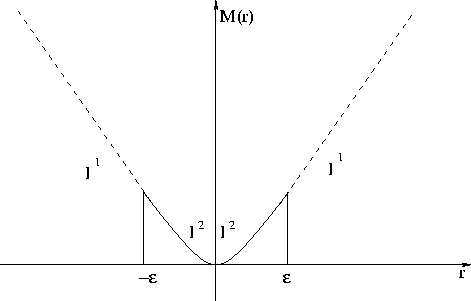




Next: What will I do?
Up: THEORY
Previous: How to design a
The hybrid l1-l2 norm has been widely used in geophysics
Bube and Langan (1997); Fomel and Claerbout (1995); Nichols (1994).
It is generally solved using iteratively reweighted least-squares (IRLS) algorithms with
an appropriate weighting matrix. These algorithms have proved efficient
but are also acknowledged to be difficult to tune.
As an alternative to using IRLS algorithms to compute the hybrid l1-l2 norm,
Claerbout (1996) introduced the Huber norm Huber (1973). This norm
is a patching of the l1 norm for high residuals and of the l2 norm for small
residuals:
|  |
(4) |
where r is the residual.
We call  the Huber misfit function, or
the Huber function, for short (Figure 2).
Note that the Huber function is smooth near zero residual and weights small residuals by
the mean square. It is reasonable to suppose that the Huber function, while maintaining
robustness against large residuals, is easier to minimize than l1.
The parameter
the Huber misfit function, or
the Huber function, for short (Figure 2).
Note that the Huber function is smooth near zero residual and weights small residuals by
the mean square. It is reasonable to suppose that the Huber function, while maintaining
robustness against large residuals, is easier to minimize than l1.
The parameter  , which controls the limit between l1 and l2, is
called the Huber threshold.
, which controls the limit between l1 and l2, is
called the Huber threshold.
huber
Figure 2 Error measure proposed by
Huber (1973). The upper part above  is the l1 norm, while the lower
part is the l2 norm. is the l1 norm, while the lower
part is the l2 norm.
|
|  |

The implementation of an inverse solver to minimize the Huber function is quite
challenging and leads to innovative non-linear algorithms in geophysics Guitton (2000b). To summarize,
I developed a quasi-Newton method with a line search. I implemented a More and Thuente
Line Search More and Thuente (1994) algorithm, which ensures a sufficient decrease in the
objective function f (equation 3) and obeys curvature conditions
(the so-called Wolfe conditions, Kelley (1999)).
The update of the Hessian is made using a Limited Memory BFGS method
as proposed by Nocedal (1980) and Liu and Nocedal (1989). This method is guaranteed
to converge to a minimum. This strategy has proved efficient in solving the Huber
problem correctly Guitton and Symes (1999); Guitton (2000a) and eliminates the restart parameter encountered in
IRLS algorithms, which makes this Huber solver easier to use.





Next: What will I do?
Up: THEORY
Previous: How to design a
Stanford Exploration Project
4/27/2000
